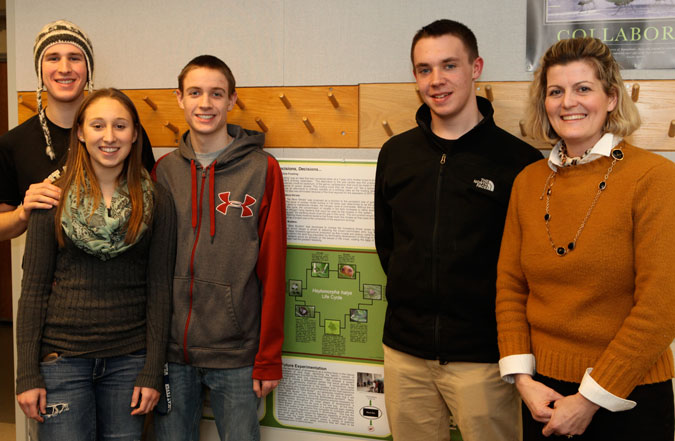BioBuilder’s Biotech Clubs support student-driven STEM projects
From Natalie Kuldell and Melissa Wu
 Synthetic biology, one of the newest areas of research, combines biology and engineering to construct biological systems with new purposes. As a new field, synthetic biology is of interest to secondary and post-secondary school teachers and students, but very little formal curriculum is available to introduce the content into the classroom. In 2011, BioBuilder was founded with the mission of introducing synthetic biology to a wider population. With input from both high school teachers and researchers at MIT, our BioBuilder modules introduce current synthetic biology research questions through online animations, hands-on investigative modules and data sharing portals. Written with flexibility in mind, BioBuilder has allowed 100s of teachers around the country to emphasize engineering, molecular biology, and scientific inquiry in their classrooms. Synthetic biology, one of the newest areas of research, combines biology and engineering to construct biological systems with new purposes. As a new field, synthetic biology is of interest to secondary and post-secondary school teachers and students, but very little formal curriculum is available to introduce the content into the classroom. In 2011, BioBuilder was founded with the mission of introducing synthetic biology to a wider population. With input from both high school teachers and researchers at MIT, our BioBuilder modules introduce current synthetic biology research questions through online animations, hands-on investigative modules and data sharing portals. Written with flexibility in mind, BioBuilder has allowed 100s of teachers around the country to emphasize engineering, molecular biology, and scientific inquiry in their classrooms.
This year, we at BioBuilder embarked on yet another experiment: to see if we could foster an out-of-school BioBuilding club for students. Students who joined the BioBuilder Biotech Club worked with guidance from their teachers as well as mentorship from the BioBuilder community to find real-world problems they wanted to address with a biotechnology and to design the biotechnologies that address the challenges. With a grant from Biogen Idec, BioBuilder provided student teams with a minimally structured virtual space as they worked on long-term projects of their own design. Four high school teachers from the Northeast volunteered to set up BioBuilder Biotech Clubs in their schools, where teams of students threw themselves into research, engineering, and experimentation. Local teachers mentored the teams through BioBuilder lab activities and video lessons. Throughout the academic year, representatives from the teams met online with BioBuilder President, Dr. Natalie Kuldell from MIT’s Department of Biological Engineering, to exchange ideas and troubleshoot problems. Scientists from Biogen Idec’s Community Lab also provided mentorship to the nearby Somerville teams.
Though the BioBuilder after-school program has only been in place for a half-year, the results have been stunning. The student teams decided to tackle big problems and to seek solutions for problems they have encountered themselves. For instance, a school stink bug infestation inspired the design of an engineered bacteria that could slow down or stop stink bug reproduction. Another project investigating natural, low-cost materials for water filtration was inspired by a student’s trip to India.
Although the projects spanned a wide breadth of topics, shared lessons and practices emerged. For example, brainstorming by the teams led to extensive literature research for them all. Designs were consistently evaluated before, during and after the experimental process. Tough questions, like the feasibility of certain project designs, arose and required teams to ask whether their solutions would positively impact society. Despite the difficulty of the tasks, students found challenges (like finding that the oil content of Fritos inhibited DNA isolation) only spurred them to further innovation. Through their own work and by observing the progress of other clubs, the students learned that getting answers about a federally funded research project isn’t always the fastest process and that the pace of research and development is not constant.
The teachers leading the BioBuilder Biotech Club have seen how this approach encourages learning of synthetic biology and the engineering design process. Despite the pressure their students feel from additional school-work and extra-curriculars, the teachers have reported that the students are loving the afterschool biodesign clubs, and that the club meetings would often attract attention from passers-by. Teachers note that many students remain excited to pursue their projects even after the culminating summit presentations, and that the students are looking forward to future years of the BioBuilder Biotech Club. The excitement of participating in a growing field and being able to tackle real-world problems may have helped to seed and sustain interest.
With these clubs, students have their own scientific community. Connections between the different BioBuilder clubs and between upper- and under-classmen within clubs stimulate conversation and the sharing of ideas. These traits are hallmarks of true scientific communities. From all reports, the inaugural effort has been rewarding and a success so far. We are looking forward to seeing this first cohort of students progress in their projects, and the starting of several new BioBuilder Biotech Clubs next fall.
Natalie Kuldell is an instructor of Biological Engineering at MIT and Melissa Wu is the BioBuilder’s Workshop Program Director.

Tyngsborough MA High School BioBuilder Biotech Club and their team mentor,
Rebekah Ravgiala show off a poster of their project, "Stinkbusters."
Back to newsletter |